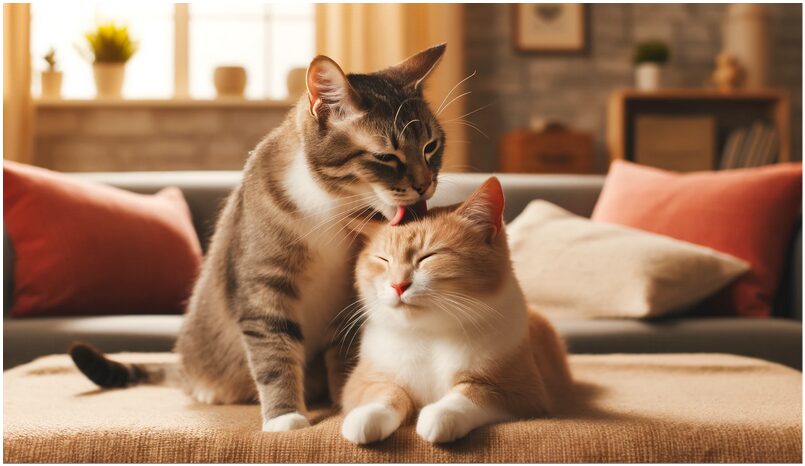Deciding to bring a second (or third, or fourth) cat into your home is a significant decision that requires careful consideration. While the idea of having a house full of feline companions might seem delightful, it’s essential to weigh the pros and cons of a multi-cat household. Additionally, adopting bonded pairs and strategies to minimize conflicts are crucial aspects to consider. Let’s dive in!
The Pros of a Multi-Cat Household
- Companionship for Your Cat: Cats are often seen as solitary creatures, but many actually enjoy the company of another cat. A companion can help reduce loneliness and boredom, especially if you are away from home frequently.
- Increased Play and Exercise: With a fellow feline around, your cat will have a constant playmate. This can lead to increased physical activity, which is beneficial for their health.
- Mental Stimulation: Interacting with another cat can provide mental stimulation that solo cats might lack. This can help prevent behavioral issues caused by boredom.
- Socialization: Having multiple cats can help them develop better social skills. They learn to communicate and interact with one another, which can be beneficial for their overall well-being.
- Double the Love: More cats mean more cuddles, purrs, and love to go around. The joy of watching your cats bond and interact can be incredibly rewarding.
The Cons of a Multi-Cat Household
- Increased Expenses: More cats mean more money spent on food, litter, toys, and veterinary care. It’s important to ensure that you have the financial resources to support multiple cats.
- Potential for Conflict: Cats can be territorial, and introducing a new cat can lead to conflicts. It’s essential to manage introductions carefully to minimize stress and aggression.
- More Cleaning: Multiple cats mean more litter boxes to clean and more fur around the house. Maintaining a clean environment requires extra effort.
- Time and Attention: Each cat needs individual attention and care. Ensure you have the time to devote to each cat to keep them happy and healthy.
- Health Risks: Multiple cats can increase the risk of spreading illnesses or parasites. Regular veterinary check-ups and vaccinations are crucial.
Adopting a Bonded Pair
Adopting a bonded pair of cats can be a wonderful experience. Bonded pairs are cats that have a deep emotional connection and prefer to stay together. Here are some benefits of adopting a bonded pair:
- Built-In Companionship: Bonded pairs are already accustomed to each other’s presence, which means you won’t have to worry about introducing them.
- Reduced Stress: These cats are likely to be less stressed in a new environment since they have each other for comfort and support.
- Less Loneliness: Bonded pairs keep each other company, which is especially beneficial if you are out of the house frequently.
- Easier Transition: The transition to a new home can be smoother for bonded pairs, as they have a familiar friend with them.
- Double the Joy: Watching a bonded pair interact can be incredibly heartwarming. Their mutual affection and playful interactions bring joy to any household.
Minimizing Conflict in a Multi-Cat Household
Introducing new cats to your household can be challenging, but with careful planning and patience, you can minimize conflict. Here are some tips to help:
- Gradual Introductions: Start by keeping the new cat in a separate room. Allow the cats to sniff each other under the door and gradually introduce them face-to-face.
- Positive Associations: Use treats and toys to create positive associations with each other’s presence. Reward calm and friendly behavior.
- Separate Resources: Ensure each cat has its own set of resources, including food bowls, water dishes, and sleeping areas, to reduce competition.
- N+1 Litterbox Rule: The N+1 rule suggests having one more litter box than the number of cats. For example, if you have two cats, provide three litter boxes. This helps prevent territorial disputes over litter boxes.
- Vertical Space: Provide plenty of vertical space, such as cat trees and shelves, to allow cats to escape and observe from a height. This can help reduce tension and give them a sense of security.
- Monitor Interactions: Keep an eye on their interactions, especially in the early stages. Be ready to intervene if things get too heated, and never punish cats for aggressive behavior, as it can worsen the situation.
- Consult a Veterinarian or Behaviorist: If conflicts persist, seek advice from a veterinarian or a cat behaviorist. They can provide personalized strategies to help your cats coexist peacefully.
Conclusion
Bringing another cat into your home is a big decision that comes with both rewards and challenges. While a multi-cat household can provide companionship, increased play, and mental stimulation for your cats, it also requires careful management of potential conflicts and increased responsibilities. Adopting a bonded pair can be a fantastic option, offering many benefits for both you and the cats. By following strategies to minimize conflict and ensuring you have the resources to support multiple cats, you can create a harmonious and happy multi-cat household.
For more tips and advice on managing a multi-cat household, visit How Many Litter Boxes Do Your Cats Really Need To Be Happy.






